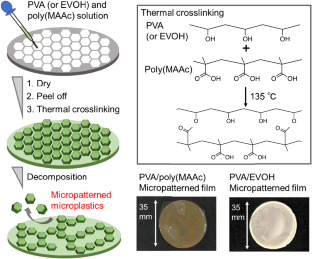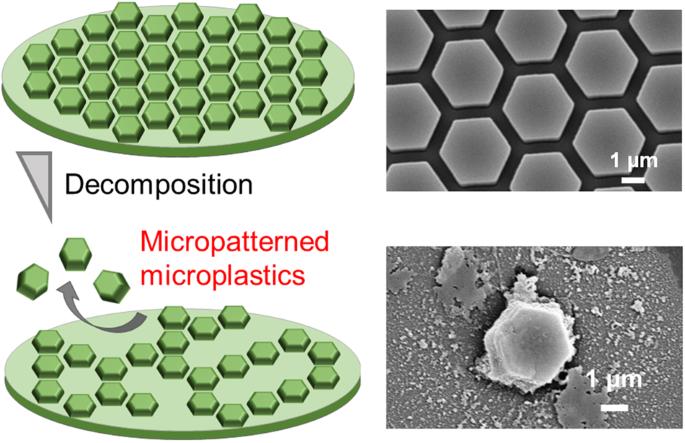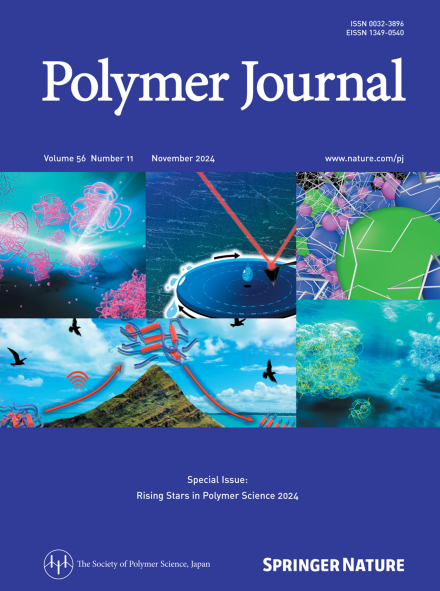Micropatterned microplastic generation via degradation of polymeric films with micropatterned structures
IF 2.3
4区 化学
Q3 POLYMER SCIENCE
引用次数: 0
Abstract
Water-insoluble micropatterned films were prepared from poly(vinyl alcohol) (PVA) (or ethylene-vinyl alcohol copolymer (EVOH)) and poly(methacrylic acid) (poly(MAAc)). The carboxy groups in poly(MAAc) underwent dehydration reactions with the hydroxy groups in the vinyl alcohol units during heating at 135 °C, which resulted in crosslinking with ester bonds and formation of a polymeric network in the micropatterned films. The surface structures of the micropatterned films and the shapes of the peeled microplastics in the supernatant were measured after decomposition in an oxidizing environment, after ultrasonic irradiation, and with both. The results revealed that the micropatterns could be peeled off from the films after they were subjected to appropriate decomposition conditions and maintained their patterned shapes. Water-insoluble micropatterned films were prepared from poly(vinyl alcohol) (PVA) (or ethylene-vinyl alcohol copolymer (EVOH)) and poly(methacrylic acid) (poly(MAAc)). The carboxy groups in poly(MAAc) underwent dehydration reactions with the hydroxy groups in the vinyl alcohol units during heating at 135 °C, which resulted in the introduction of a crosslinked structure with ester bonds into the polymeric network of the micropatterned films. The micropatterns could be peeled off from the films after decomposition and maintained their patterned shapes.


通过具有微图案结构的聚合物薄膜降解生成微图案微塑料
用聚(乙烯醇)(PVA)(或乙烯-乙烯醇共聚物(EVOH))和聚(甲基丙烯酸)(poly(MAAc))制备了不溶于水的微图案薄膜。在 135 °C 的加热过程中,聚(甲基丙烯酸)中的羧基与乙烯醇单元中的羟基发生脱水反应,从而与酯键交联,在微图案薄膜中形成聚合物网络。测量了微图案薄膜在氧化环境中分解后、超声波辐照后以及两者同时分解后的表面结构和上清液中剥离的微塑料的形状。结果表明,在适当的分解条件下,微图案可以从薄膜上剥离,并保持其图案形状。
本文章由计算机程序翻译,如有差异,请以英文原文为准。
求助全文
约1分钟内获得全文
求助全文
来源期刊

Polymer Journal
化学-高分子科学
CiteScore
5.60
自引率
7.10%
发文量
131
审稿时长
2.5 months
期刊介绍:
Polymer Journal promotes research from all aspects of polymer science from anywhere in the world and aims to provide an integrated platform for scientific communication that assists the advancement of polymer science and related fields. The journal publishes Original Articles, Notes, Short Communications and Reviews.
Subject areas and topics of particular interest within the journal''s scope include, but are not limited to, those listed below:
Polymer synthesis and reactions
Polymer structures
Physical properties of polymers
Polymer surface and interfaces
Functional polymers
Supramolecular polymers
Self-assembled materials
Biopolymers and bio-related polymer materials
Polymer engineering.
 求助内容:
求助内容: 应助结果提醒方式:
应助结果提醒方式:


